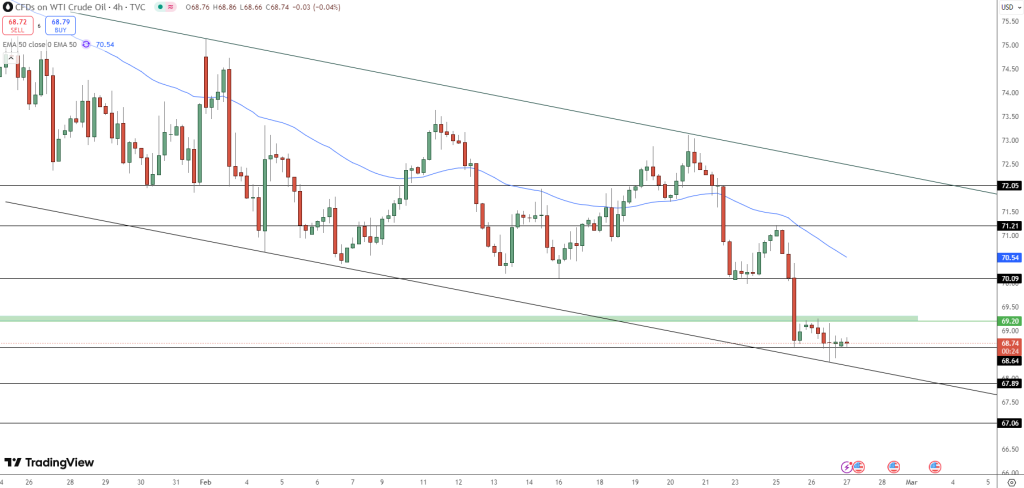WTI Crude Oil Falls to $68.74: Will It Drop Below $67.89?
WTI Crude Oil fell to $68.74 on February 27, 2025, continuing its downward momentum for the third consecutive day.

The decline follows U.S. President Donald Trump’s decision to reverse the license granted to Chevron (CVX), restricting its operations in Venezuela. This move threatens to disrupt 240,000 barrels per day of crude exports, over a quarter of Venezuela’s total output.
The announcement triggered a brief recovery in oil prices due to supply concerns, but the rally was short-lived. Oil remains under pressure from a surprise increase in U.S. fuel inventories, signaling weakening demand. According to the Energy Information Administration (EIA), gasoline and distillate stocks rose unexpectedly, while crude inventories declined.
Compounding the bearish sentiment, potential peace talks between Russia and Ukraine are raising hopes of a ceasefire, easing geopolitical tensions that have supported oil prices in recent months. Analysts caution that the market could remain volatile as investors monitor developments in the Russia-Ukraine negotiations and upcoming economic data.
Crude Oil Technical Analysis: Bearish Momentum Below Key Levels
WTI Crude Oil is trading within a descending channel, maintaining a bearish trend as it stays below the 50-day Exponential Moving Average (EMA) at $70.54. The breakdown below the critical support at $70.09 triggered a move to $69.20, which temporarily acted as support but has now flipped into resistance. This failure to reclaim $69.20 indicates continued selling pressure.
The next immediate support lies at $67.89, with a more substantial floor at $67.06. A decisive break below $67.89 could lead to further declines, potentially targeting the lower boundary of the descending channel. Conversely, if buyers regain momentum, resistance levels to watch are at $69.20 and $70.09, with the 50 EMA at $70.54 acting as a critical barrier.
The overall trend remains bearish as long as WTI Crude trades below the 50 EMA and within the descending channel. The formation of lower highs and lower lows on the 4-hour chart reinforces the downtrend.
Key Levels to Watch:
Immediate Resistance: $69.20
Next Resistance: $70.09
Immediate Support: $67.89
Major Support: $67.06
USOIL Market Outlook: Supply Uncertainty and Geopolitical Tensions
Oil traders are closely monitoring supply dynamics following Trump’s reversal of Chevron’s license in Venezuela. This policy shift comes amid Trump’s ongoing criticism of former President Joe Biden’s decision to tap into the Strategic Petroleum Reserve (SPR), aimed at controlling gasoline prices. Trump recently stated his intention to refill the SPR rapidly, potentially supporting oil prices in the short term.

However, market participants remain cautious as geopolitical developments unfold. Trump’s Russian-Ukrainian peace talks are drawing attention, with Ukrainian President Volodymyr Zelenskiy expected to visit Washington. Any progress in ceasefire negotiations could ease geopolitical risk premiums, further pressuring oil prices.
Adding to the uncertainty, Goldman Sachs maintained its Brent crude baseline forecast within the $70-$85 range, citing the U.S. administration’s dual goals of maintaining commodity dominance while ensuring affordability. The investment bank predicts that this range is favorable for robust U.S. supply growth.
Summary and Strategic Insights:
Bearish Momentum Continues: WTI remains below $70.09 and the 50 EMA at $70.54.
Key Support at $67.89: A break could target $67.06.
Geopolitical Factors at Play: Watch for updates on U.S.-Venezuela policy and Russia-Ukraine peace talks.
Goldman Sachs Forecast: Brent expected to stay in the $70-$85 range, influencing WTI dynamics.












